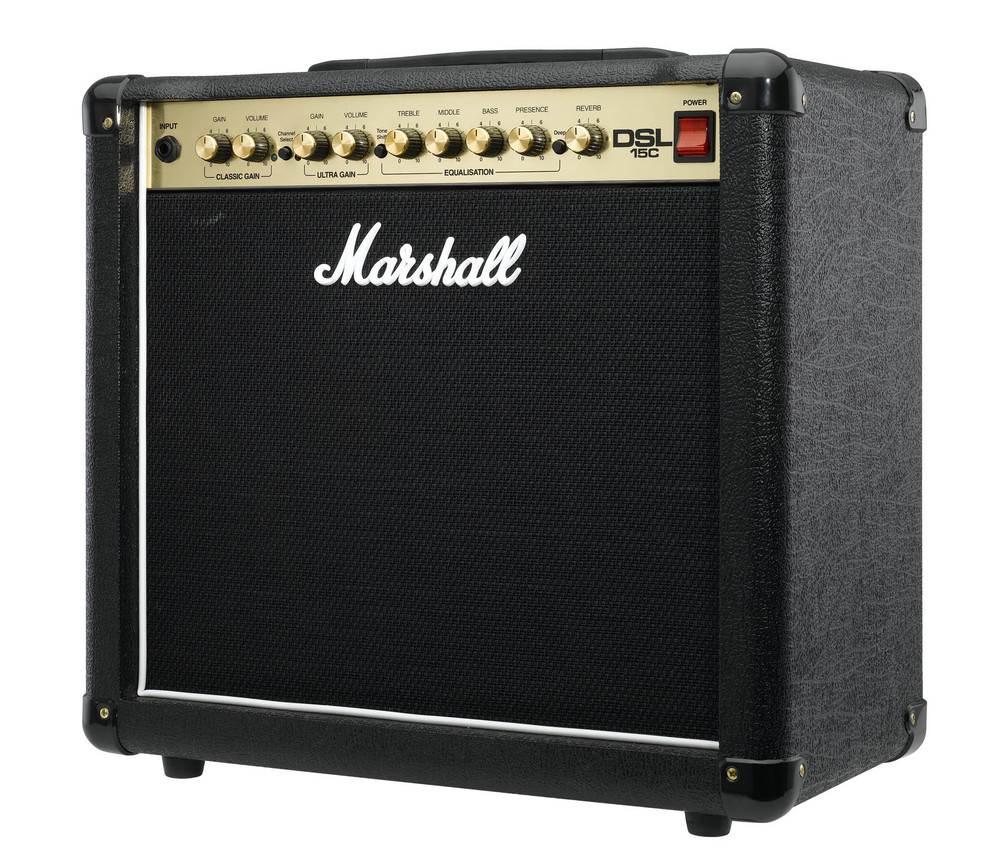Marshall DSL15C and DSL40C review

There are many different shades of the Marshall sound, but every Marshall amp—from the Plexi through the JCM800 and Jubilee to the latest JVM models—delivers a certain instantly identifiable quality of tone, crunch and distortion.
That unmistakable Marshall character is very alive and well in the company’s latest DSL models, which deliver an incredible variety of classic and modern Marshall tones at exceptionally affordable prices, offering possibly the best value of any tube amp line in Marshall’s long, illustrious history.
The four latest additions to the DSL line include the DSL15H 15-watt head, the DSL15C 15-watt 1x10 combo amp, DSL40C 40-watt 1x12 combo and the DSL100H 100-watt head. Each boasts all-tube circuitry, a dual-channel design, full/half power switch, digital reverb and more. Amazing, each sells for a street price of under $1,000. For this review, I tried out the two combo models—the DSL15C and DSL40C—which deliver impressive power in portable packages.
Features
Both the DSL15C and DSL40C share certain features, but a handful of differences beyond power output and speaker size are worthy of consideration if choosing between the two. The DSL15C has an ECC83 (12AX7) and a pair of 6V6 power amp tubes, and it has three ECC83 tubes in the preamp section; the DSL40C uses two EL34 tubes for the power amp instead of 6V6s.
The DSL40C has a slight edge in versatility, especially for guitarists who plan on using the amp onstage, thanks to two selectable modes per channel (Clean/Crunch for the Classic Gain channel, and Lead 1/Lead 2 for the Ultra Gain channel), a resonance control, individual reverb level controls for each channel and a series effect loop. Instead of a resonance control, the DSL15C offers a deep switch. The DSL40C has a Celestion Seventy 80 12-inch speaker, while the DSL15C comes with a Celestion G12E-60 10-inch speaker. The DSL40C also weighs about 15 pounds more than the DSL15C.
Common features of both amps include Classic Gain and Ultra Gain channels, each of which has its own gain and volume controls but shares a single set of treble, middle, bass and presence controls and a tone shift switch that scoops the midrange when engaged. A footswitch with individual switches for selecting the channel and bypassing reverb also comes with both models. The rear panels of both models provide a pentode/triode switch (for full- or half-power settings), a footswitch jack, a single 16-ohm speaker output jack, and two eight-ohm speaker output jacks.
Get The Pick Newsletter
All the latest guitar news, interviews, lessons, reviews, deals and more, direct to your inbox!
Performance
The two selectable modes per channel on the DSL40C give it a slight edge in versatility compared to the DSL15C, but both combos provide a full selection of Marshall tones, including sparkling clean, raunchy crunch, aggressive overdrive and ultraviolent modern metal distortion.
The biggest differences are that the DSL40C’s Crunch setting provides more overdrive than is available from the DSL15C’s Classic Gain channel and the Lead 2 setting adds thicker midrange than you can get from the DSL15C’s Ultra Gain channel. However, thanks to its 6V6 tubes, the DSL15C’s distortion tones are slightly more dynamic, tight and harmonically complex compared to the somewhat compressed and darker tones of the DSL40C’s EL34 tubes.
The tone controls on both models offer much greater tonal range than the average guitar amp, with the treble and presence controls providing particularly sharp, brilliant textures past the one o’clock mark. However, the added range actually makes it easier to dial in pretty much any tone one desires, from the razor-sharp cut of Kerry King’s thrash tones to the hammer-of-the-gods bottom-end punch of James Hetfield’s Ride the Lightning rhythm guitars. Although the combos’ cabinets have open-back designs, the resonance control (DSL40C) and the deep switch (DSL15C) allow these amps to deliver tight, focused bass similar to that of a closed-back 4x12 cabinet.
Both amps are loud enough for small gigs or miking through a sound system, and the half-power settings make either ideal for playing at more moderate volume levels at home. The DSL40C is a better choice for playing live, thanks to its more powerful output, effect loop and individual reverb controls, while the DSL15C is a studio powerhouse that provides a lifetime’s worth of awesome Marshall tones that are perfect for recording.
Cheat Sheet
List Prices DSL15C, $840; DSL40C, $970
MANUFACTURER Marshall Amplification, marshallamps.com
The DSL15C features one ECC83 and two 6V6 tubes in the power amp section, while the DSL40C features one ECC83 and two EL34 tubes.
Both combos feature a shared EQ section for both channels, a Classic Gain channel, an Ultra Gain channel, a tone shift switch, digital spring reverb and a pentode/triode switch.
The DSL40C adds a Clean/Crunch mode switch for the Classic Gain channel, Lead 1/Lead 2 mode switch for the Ultra Gain channel, and effect loop, resonance control and individual reverb controls for each channel.
Both models include a controller with two footswitches for selecting channels and turning reverb on or off.
The Bottom Line
Marshall’s new DSL Series combos deliver an impressive variety of classic and modern Marshall tones in compact, portable packages that are perfect for the stage or studio.
Chris is the co-author of Eruption - Conversations with Eddie Van Halen. He is a 40-year music industry veteran who started at Boardwalk Entertainment (Joan Jett, Night Ranger) and Roland US before becoming a guitar journalist in 1991. He has interviewed more than 600 artists, written more than 1,400 product reviews and contributed to Jeff Beck’s Beck 01: Hot Rods and Rock & Roll and Eric Clapton’s Six String Stories.
"I never use my tube amp at home now, because I have a Spark Live": 5 reasons you should be picking up the Positive Grid Spark Live in the massive Guitar Month sale
“Our goal is to stay at the forefront of amplification innovation”: How Seymour Duncan set out to create the ultimate bass amp solution by pushing its PowerStage lineup to greater heights











